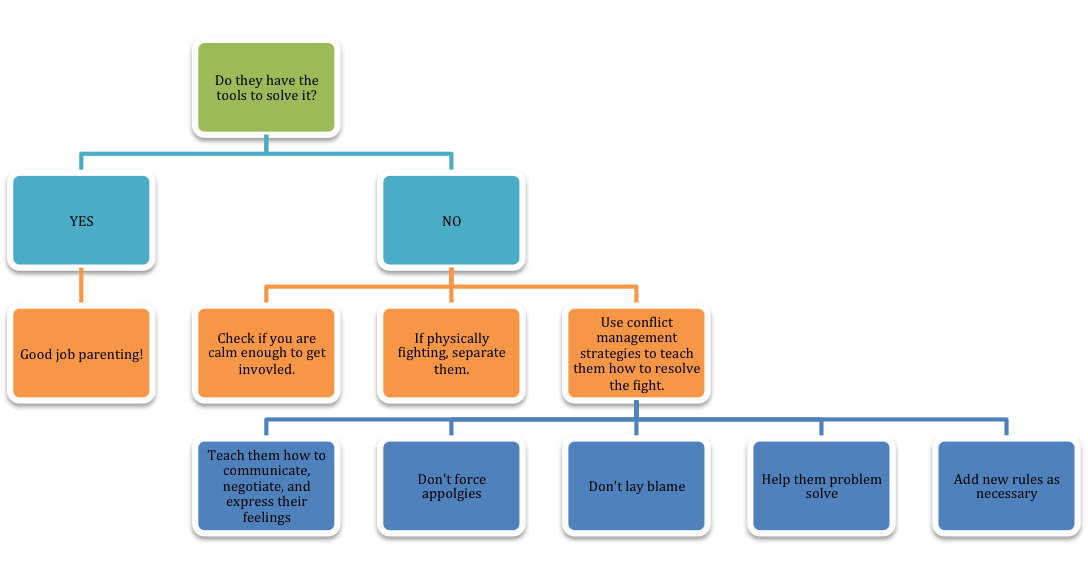You look at your children and marvel in their awesomeness, how they are growing so quickly right before your eyes. And then…they start playing with their sibling, gloves come off and it’s fight time! Sibling rivalry – I bet you talk to your friends about it, wish it would never happen in your home and wonder how they can play with their friends but fight so much with their siblings!
Sibling rivalry can be challenging for parents and can affect the entire family. Before you read on, if you are looking for a quick one-time fix or want sibling rivalry to come to end in your home, let me tell you – it is not going to happen. Sibling fights can actually be great teaching and learning opportunities for your kiddos. Moms and Dads, take a deep breath, you cannot rid your home of the dreaded fights, but you can change how often they happen and what they look like.
So why do your kids fight so much? Many of the reasons why they fight have to do with the contingencies in place – between the siblings, and with you, the parent. Like all behaviours, there are contingencies we come into contact with that either strengthen or weaken behaviours. If we have favorable outcomes, we’re more likely to engage in that behaviour in the future. If however, we come into contact with unfavorable outcomes, we’re less likely to do those behaviours in the future. The contingencies in the rivalry are what have the largest impact, and I believe the area where you, as a parent, can have the most effect. It is worthwhile, however, to highlight some other reasons why your kids might be fighting: developmental levels, sex and age, parenting styles, and boredom. It is important for you to recognize all the factors for your children’s behavior that might be affecting why and how often they are fighting with each other.
You as parents can change what sibling rivalry looks like and how often it happens. But remember, it’s not going to go away completely, and that’s okay!
Step 1 – Figure out what’s going on (the contingencies).
- Pay attention to when your kids are fighting. Is it always over the same game or toy? Is it always before dinnertime? Or is it when you’re busy and they have to play by themselves?
- Listen to them play, interact, and how the fight starts and then how it evolves. Does one child seem to be the instigator? How do the kids respond to each other?
- When do you step in – do you wait until the fight gets worse before you go into parent?
- How do you get involved – what do you say? How do you say it, are you yelling and screaming? Do you always take away the toy or make threats that you will? Do you separate the kids? Does one child feel like his sister is being favored?
Once you’ve done that, consider how the before-mentioned questions have an impact on sibling rivalry in your home. Where can you make realistic changes?
Step 2 – Change the contingencies.
- Set them up for success – give them games and toys that they are less likely to fight over, provide more structure for younger children if they need it, and sometimes put everything away and play with them!
- Teach them the good stuff – your children need you to teach them appropriate social skills. Show them how to talk to one another, how to ask for something, how to share.
- Teach them how to problem solve – in conflict situations, your children need to be taught how to resolve conflict. As a parent, you need to teach your kids what to do when they don’t get their way, or when the younger brother doesn’t play soccer exactly how big brother wants him to. Remember, if you go into the fight zone escalated, you’re teaching them that as a response to conflict.
- Praise – Praise – Praise – when they are playing nicely, and getting along, make sure they know that you see it and that you’re happy about it.
- Give Attention – if your kids are seeking your attention, give it to them. But not when they start fighting, if they know you’ll only give them attention when they fight, that’s what they will do!
- Set House rules – don’t makeup rules as fights come up or depending on how loud and intense the fight gets. Let kids know what the rules are in your home, and remind them of the rules before they start playing. Keep them simple, and don’t forget to change the rules (with your kids) as they develop and grow. And stay consistent!
If sibling rivalry is increasing and all-consuming, you may want to consult an expert who can help design a program that works for your family. For those interested in a more clinical approach to reducing sibling rivalry, or designing a program for parents, take a look at Leitenberg et., al. (1977), who looked at two different reinforcement procedures and their effects on sibling rivalry. Take a look also at Tiedmann & Johnston (1992) who evaluated a parent training program to help siblings learn sharing skills. And from my personal favorites, when training parents and children, see my previous article on Behavioral Skills Training (BST)!
In moments of conflict, remember to check how you are feeling and if you are calm enough to get involved. How you respond to your children’s fighting teaches them how to respond to each other! Here’s a quick tip on what to do when a fight breaks out:

As a parent, it is up to you to teach your children how to play with others, how to interact appropriately, and resolve conflict when it does arise. Your kids are going to fight, accept it. How intense those fights get, and how often they occur, you can change. Using effective strategies in your home will make for happy playtimes!
REFERENCES
Leitenberg, H., Burchard, J.D., Burchard, S. N., Fuller, E. J., & Lysaght, T.V. (1977). Using positive reinforcement to suppress behavior: some experimental comparisons with sibling conflict. Behavior Therapy, 8, 168-182.
Tiedmann, G. L. & Johnston, C. (1992). Evaluation of a parent training program to promote sharing between young siblings. Behavior Therapy, 23, 299-318.









